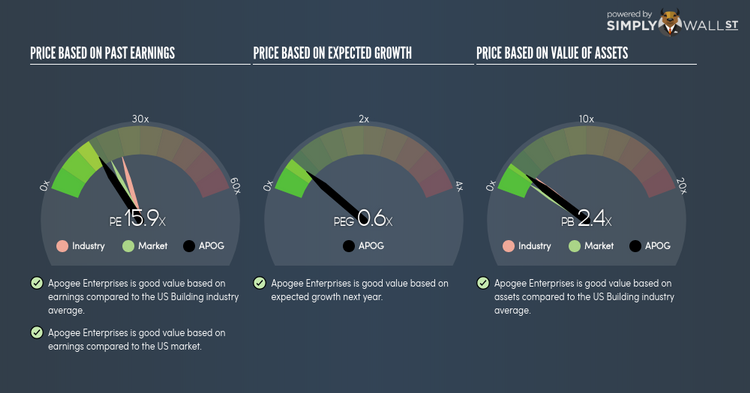March Undervalued Stocks To Look Out For

Apogee Enterprises and Spark Energy are two of the stocks I have identified as undervalued. This means their current share prices are trading at levels less than what the companies are actually worth. Investors can benefit from buying these companies while they are discounted, because they gain when the market prices move towards the stocks’ true values. Below is a list of stocks I’ve compiled that are deemed undervalued based on the latest financial data.
Apogee Enterprises, Inc. (NASDAQ:APOG)
Apogee Enterprises, Inc. designs and develops glass products and services in the United States, Canada, and Brazil. Started in 1949, and now led by CEO Joseph Puishys, the company employs 5,511 people and with the company’s market cap sitting at USD $1.29B, it falls under the small-cap stocks category.
APOG’s stock is currently floating at around -36% below its intrinsic value of $68.65, at a price tag of US$44.23, based on my discounted cash flow model. This discrepancy gives us a chance to invest in APOG at a discount. Moreover, APOG’s PE ratio is currently around 15.86x relative to its Building peer level of, 23.21x meaning that relative to its competitors, APOG’s stock can be bought at a cheaper price. APOG is also in great financial shape, with near-term assets able to cover upcoming and long-term liabilities.
More on Apogee Enterprises here.
Spark Energy, Inc. (NASDAQ:SPKE)
Spark Energy, Inc., through its subsidiaries, operates as an independent retail energy services company in the United States. Formed in 1999, and currently headed by CEO Nathan Kroeker, the company currently employs 143 people and with the company’s market capitalisation at USD $330.72M, we can put it in the small-cap category.
SPKE’s stock is now hovering at around -76% less than its true level of $38.39, at a price of US$9.25, based on its expected future cash flows. The difference between value and price signals a potential opportunity to buy SPKE shares at a discount. Moreover, SPKE’s PE ratio is around 10.68x while its Electric Utilities peer level trades at, 16.96x indicating that relative to other stocks in the industry, we can invest in SPKE at a lower price. SPKE is also a financially robust company, as short-term assets amply cover upcoming and long-term liabilities.
Interested in Spark Energy? Find out more here.
Westlake Chemical Partners LP (NYSE:WLKP)
Westlake Chemical Partners LP operates, acquires, and develops ethylene production facilities and related assets in the United States. Westlake Chemical Partners was founded in 2014 and has a market cap of USD $762.35M, putting it in the small-cap stocks category.
WLKP’s shares are currently floating at around -27% under its intrinsic level of $32.37, at a price tag of US$23.55, based on my discounted cash flow model. This difference in price and value gives us a chance to buy low. Furthermore, WLKP’s PE ratio stands at 16.15x while its Chemicals peer level trades at, 19.58x suggesting that relative to its competitors, WLKP can be bought at a cheaper price right now. WLKP is also robust in terms of financial health, with short-term assets covering liabilities in the near future as well as in the long run. It’s debt-to-equity ratio of 47.46% has been falling for the past few years revealing WLKP’s capability to reduce its debt obligations year on year. More detail on Westlake Chemical Partners here.
For more financially sound, undervalued companies to add to your portfolio, you can use our free platform to explore our interactive list of undervalued stocks.
To help readers see pass the short term volatility of the financial market, we aim to bring you a long-term focused research analysis purely driven by fundamental data. Note that our analysis does not factor in the latest price sensitive company announcements.
The author is an independent contributor and at the time of publication had no position in the stocks mentioned.



